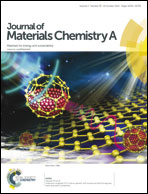Microporous titanate nanofibers for highly efficient UV-protective transparent coating
Abstract
Hydrothermal treatment of a layered titanate (K2Ti2O5) in the presence of tetrapropylammonium hydroxide and ammonium fluoride, inspired by a zeolite synthesis method called interzeolite conversion, produced a new titania-based material, a microporous titanate nanofiber. Judging from a variety of analyses such as high resolution transmission electron microscopy, Ar adsorption/desorption and adsorption of small and large cations from aqueous solutions, the product had several one-dimensional channels with a width less than 1 nm in a nanofiber. This new material showed a well-restrained photocatalytic activity, which was evaluated by the oxidation of cyclohexane and 2-propanol, and the activity was considerably lower than that of a photocatalytically inactive rutile-type TiO2. The material also exhibited an extremely low refractive index (approximately 1.7). Thanks to these unique photoproperties, a microporous titanate nanofiber was successfully embedded in a commodity organic polymer (polycaprolactone) and then used as a highly efficient ultraviolet light (UV) protective transparent coating on a UV-sensitive substrate.


 Please wait while we load your content...
Please wait while we load your content...